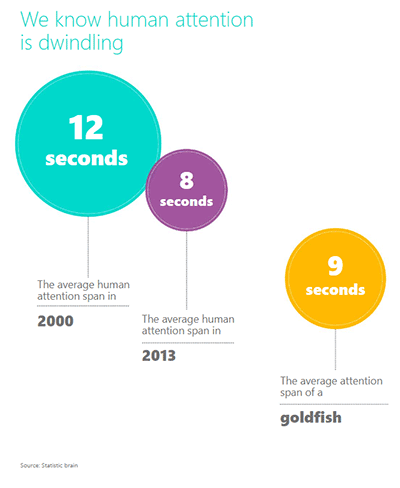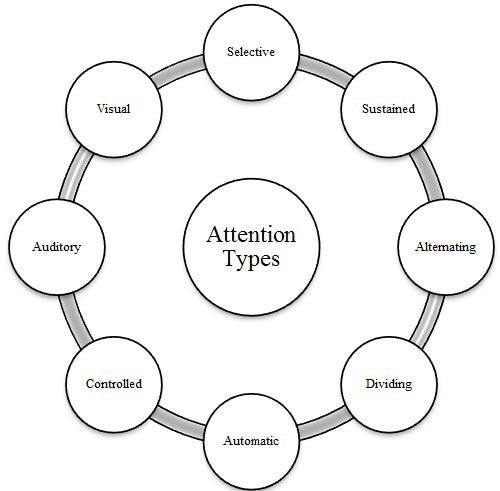The attention span myth
No, the average human attention span is not 1 second less than that of the goldfish.
The average attention span for the notoriously ill-focused goldfish is nine seconds, but according to a new study from Microsoft Corp., people now generally lose concentration after eight seconds, highlighting the affects of an increasingly digitalized lifestyle on the brain — Time Magazine
In 2015 most major publications like the Time Magazine quoted above reported that a human’s attention span is only eight seconds long — one second shorter than the attention span of a goldfish. You have probably heard this myth multiple times — you might even believe it yourself. Good news: we do not have 8-second attention spans. Let me explain below…
Simon Maybin looked into the origins of this myth in a 2017 BBC article and uncovered something… fishy. Two years earlier, the consumer insight team at Microsoft Canada released a report called Attention Spans which included the now-famous statistic about human and goldfish attention spans. The report was based on a series of studies looking at factors affecting human attention and the impact this has on marketing, but the headline was not derived from that research. The statistic was included in a figure (see below), which was based on information provided by Statistic Brain, a research company. Maybin attempted to get in touch with them but they did not provide any support for their claim.
Sam Peña-Taylor from WARC managed to locate the original Microsoft report; you can find it here.

The information in the graph above was entirely fabricated. Not just the part about human attention but also the “goldfish fact”. Think about it. Wasn’t the original myth about goldfish memory having a 3-second memory? The factoid adapted a piece of folk knowledge to suit its persuasive purpose. It sounds familiar, therefore it is true. In fact, no one knows how to actually measure a goldfish’s attention span. What has been measured by researchers is goldfish memory, which, is actually quite good.
The 8-second attention span is not the only myth about human attention. Several authors claim that attention span declines precipitously after 10–15 min. As a result of those claims, it is often suggested that presentations/lectures/talks should last no more than 10–15 min to accommodate the biological set point of our attention span. Neil Bradbury looked into the source of the 10-minute attention span claim and discovered that it appears to rely on a single key manuscript published in 1978 describing the waning of attention during a lecture. So all that was a result of misinterpretation propagated by various academic researchers! Even experts can be victims of misinformation…
A crash course on attention
My background is in cognitive psychology and I find the idea of attention span vague and confusing. Which type of attention is this myth referring to? When we hear the term attention most of us have some idea of what it refers to.
Everyone knows what attention is. It is the taking possession by the mind, in clear and vivid form, of one out of what seem several simultaneously possible objects or trains of thought. Focalization, concentration, of consciousness are of its essence. It implies withdrawal from some things in order to deal effectively with others — William James
The above quote, while written over 100 years ago, captures the essential aspects of attention and remains relevant today. Attention refers to the cognitive processes that enable the selection of, focus on, and sustained processing of information.

Humans seem to have a limited capacity for information processing, and can only attend to or be consciously aware of a small amount of information at any given time. Kahenman’s (1983) capacity theory of attention proposed that people’s capacity for attentional focus is not static, but instead varies as a function of factors such as the reward characteristics of the task, arousal level, motivation, and other biological determinants. Let me clarify here that, in psychology, arousal refers to a general level of activity — “the state of being activated”. In simple words, our ability to pay attention depends on the task at hand and a number of external and internal factors. There isn’t a single value that can measure our “attention span”.
The idea of an “average attention span” is very much meaningless. It is task-dependent. How much attention we apply to a task varies depending on task demands. — K.R. Subramanian
Why is this myth so prevalent?
The idea of an 8-second attention span is hard to grasp; how could anyone read an article or a book or even watch a film? Certain behaviours exhibited by most people today (e.g., binge-watching, video gaming) go against this idea. For example, a Netflix survey found 61 percent of users regularly watched between two and six episodes in one sitting. So why did this myth get so popular? The literature on fake news can offer us some insight into this.
A possible explanation is motivated reasoning — the idea that our cognitive processes are biased toward believing things that conform with our worldview. In this case, having difficulty concentrating is not our fault but the result of “our attention span” deteriorating. We are not lazy, but it’s our brain’s fault.
The social aspect of this also contributes to the popularity of the myth and its acceptance. When we see people (or publication) who think like us or agree with our point of view, offering us new information that reinforces those beliefs, we’re more likely to accept them.
“It’s a team effort, and that’s where fake news gets a lot of its power,” — P. Ditto et al.
Why is this a problem?
This myth has recently fuelled the snackable content trend. This refers to website content that is designed to be easy for readers to consume and to share.
Snackable content is short, neat, and easy to consume. It’s called snackable because it’s quick and easy to digest — just like a real snack. — L. Scheiblhofer
The problem with snackable content is that it is often characterised by clickbaity titles and sacrifices content quality.
What’s the truth?
The idea of the average human attention span is meaningless. A number of factors dictate how much attention we pay to things (e.g., motivation, external distractions). Improving the quality of the experiences we provide and understanding our users and their needs is more likely to improve engagement and sustain their attention. Oh… and goldfish are really misunderstood.




